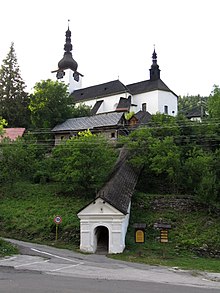Špania Dolina
Špania Dolina | ||
|---|---|---|
Village | ||
 Špania Dolina from Panský Diel | ||
|
Car plate BB | | |
| Website | www.spaniadolina.sk | |
Špania Dolina (Hungarian: Úrvölgy) is a village and municipality in central Slovakia, near the city of Banská Bystrica.[5] Although its permanent population does not exceed 200 people, it is a picturesque historic village situated 728 m above sea level and is surrounded by the Staré Hory and Veľká Fatra mountains. It has become a popular tourist recreation centre.
Name
The ancient
History



Prehistoric mining tools excavated in the territory of Špania Dolina have been dated from as early as 2000-1700 BC.
The rich region attracted many foreign visitors. The House of Fugger funded a laboratory of the famous
The ancient tradition of making bobbin lace led to the establishment of a bobbin lace craft school in 1883. The copper mines were closed down in 1888 and the economy of the village is now based primarily on tourism.
Landmarks
A covered stairway leads to a fortified church, built in the Gothic and Renaissance styles. Wooden miners' houses, now reconstructed, were originally built in the 17th and 18th centuries. The so-called "Knocker" from the 16th century served as a special bell tower for calling the miners to work in the morning. Ancient shafts and other technical monuments are scattered in the nearby forests. Špania Dolina is also a hub of hiking, mountain biking, and cross-country skiing trails.
Demographics
Špania Dolina has only 192 residents (as of December 31, 2013). According to the 2001
References
- ^ "Počet obyvateľov podľa pohlavia - obce (ročne)". www.statistics.sk (in Slovak). Statistical Office of the Slovak Republic. 2022-03-31. Retrieved 2022-03-31.
- ^ a b "Hustota obyvateľstva - obce [om7014rr_ukaz: Rozloha (Štvorcový meter)]". www.statistics.sk (in Slovak). Statistical Office of the Slovak Republic. 2022-03-31. Retrieved 2022-03-31.
- ^ a b c d "Základná charakteristika". www.statistics.sk (in Slovak). Statistical Office of the Slovak Republic. 2015-04-17. Retrieved 2022-03-31.
- ^ a b "Hustota obyvateľstva - obce". www.statistics.sk (in Slovak). Statistical Office of the Slovak Republic. 2022-03-31. Retrieved 2022-03-31.
- ^ "Špania Dolina - Okres Banská Bystrica - E-OBCE.sk". www.e-obce.sk. Retrieved Sep 29, 2020.
- ^ Browne, Edward (1696). Brief account of some travels in Hungaria, Servia, Bulgaria, Macedonia, Thessaly, Austria, Styria, Carinthia, and Friuli. pp. 106–107. Retrieved 2020-08-11.
- ^ Kázmér, Miklós; Papp, Gábor (January 2017). "KÁRPÁTI ÁSVÁNYOK EGY TIZENNYOLCADIK SZÁZADI ANGLIAI GYŰJTEMÉNYBEN" (PDF). Magyar Tudomány (in Hungarian): 68–69. Retrieved 2020-08-12.
- ^ a b "Municipal Statistics". Statistical Office of the Slovak republic. Archived from the original on 2007-11-16. Retrieved 2007-12-05.
External links
 Media related to Špania Dolina at Wikimedia Commons
Media related to Špania Dolina at Wikimedia Commons- Official website
